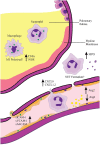Scrub Typhus Pathogenesis: Innate Immune Response and Lung Injury During Orientia tsutsugamushi Infection
- PMID: 31555249
- PMCID: PMC6742975
- DOI: 10.3389/fmicb.2019.02065
Scrub Typhus Pathogenesis: Innate Immune Response and Lung Injury During Orientia tsutsugamushi Infection
Abstract
Scrub typhus is an understudied, potentially lethal disease caused by infection with Orientia tsutsugamushi. Despite causing an estimated 1 million cases per year and an increasing global presence, mechanisms of scrub typhus pathogenesis remain unclear. One of the most life-threatening conditions that can arise in scrub typhus patients is acute respiratory distress syndrome (ARDS). The development of ARDS is a complex process; some of its pathological hallmarks, including prolonged recruitment of inflammatory immune cells to the lung and vasculature damage, have been observed in humans and/or animal models of O. tsutsugamushi infection. Although different cell types and mechanisms may contribute to ARDS development during O. tsutsugamushi infection, this review highlights our current evidence of pulmonary endothelial activation and damage, the potential roles of neutrophils and macrophages in the lung, and the knowledge gaps in this field. Continued investigation of the lung microenvironment and cellular interactions will help elucidate disease pathogenesis and possible treatment during scrub typhus.
Keywords: Orientia tsutsugamushi; acute respiratory distress syndrome; endothelial cell; macrophage; neutrophil; scrub typhus.
Figures

Similar articles
-
Murine models of scrub typhus associated with host control of Orientia tsutsugamushi infection.PLoS Negl Trop Dis. 2017 Mar 10;11(3):e0005453. doi: 10.1371/journal.pntd.0005453. eCollection 2017 Mar. PLoS Negl Trop Dis. 2017. PMID: 28282373 Free PMC article.
-
Dissemination of Orientia tsutsugamushi and inflammatory responses in a murine model of scrub typhus.PLoS Negl Trop Dis. 2014 Aug 14;8(8):e3064. doi: 10.1371/journal.pntd.0003064. eCollection 2014 Aug. PLoS Negl Trop Dis. 2014. PMID: 25122501 Free PMC article.
-
Hematogenously disseminated Orientia tsutsugamushi-infected murine model of scrub typhus [corrected].PLoS Negl Trop Dis. 2014 Jul 10;8(7):e2966. doi: 10.1371/journal.pntd.0002966. eCollection 2014 Jul. PLoS Negl Trop Dis. 2014. PMID: 25010338 Free PMC article.
-
Dysregulated Th1 Immune and Vascular Responses in Scrub Typhus Pathogenesis.J Immunol. 2018 Feb 15;200(4):1233-1240. doi: 10.4049/jimmunol.1701219. J Immunol. 2018. PMID: 29431689 Free PMC article. Review.
-
A Review of Scrub Typhus (Orientia tsutsugamushi and Related Organisms): Then, Now, and Tomorrow.Trop Med Infect Dis. 2018 Jan 17;3(1):8. doi: 10.3390/tropicalmed3010008. Trop Med Infect Dis. 2018. PMID: 30274407 Free PMC article. Review.
Cited by
-
Differential cellular immune responses against Orientia tsutsugamushi Karp and Gilliam strains following acute infection in mice.PLoS Negl Trop Dis. 2023 Dec 13;17(12):e0011445. doi: 10.1371/journal.pntd.0011445. eCollection 2023 Dec. PLoS Negl Trop Dis. 2023. PMID: 38091346 Free PMC article.
-
Neurological Facets of Scrub Typhus: A Comprehensive Narrative Review.Ann Indian Acad Neurol. 2021 Nov-Dec;24(6):849-864. doi: 10.4103/aian.aian_739_21. Epub 2021 Dec 17. Ann Indian Acad Neurol. 2021. PMID: 35359522 Free PMC article.
-
Role of Adjunctive corticoSTEROIDs on clinical outcomes in severe Scrub typhus pneumonitis: ASTEROIDS study protocol - a randomised controlled trial.BMJ Open. 2025 Aug 12;15(8):e104171. doi: 10.1136/bmjopen-2025-104171. BMJ Open. 2025. PMID: 40803720 Free PMC article.
-
Intranasal Vaccination with Outer-Membrane Protein of Orientia tsutsugamushi induces Protective Immunity Against Scrub Typhus.Immune Netw. 2020 Dec 3;21(2):e14. doi: 10.4110/in.2021.21.e14. eCollection 2021 Apr. Immune Netw. 2020. PMID: 33996170 Free PMC article.
-
Genome-Wide Association Study Identifies Eight Novel Loci for Susceptibility of Scrub Typhus and Highlights Immune-Related Signaling Pathways in Its Pathogenesis.Cells. 2021 Mar 5;10(3):570. doi: 10.3390/cells10030570. Cells. 2021. PMID: 33807835 Free PMC article.
References
-
- Adamzik M., Broll J., Steinmann J., Westendorf A. M., Rehfeld I., Kreissig C., et al. . (2013). An increased alveolar CD4 + CD25 + Foxp3 + T-regulatory cell ratio in acute respiratory distress syndrome is associated with increased 30-day mortality. Intensive Care Med. 39, 1743–1751. 10.1007/s00134-013-3036-3, PMID: - DOI - PMC - PubMed
Publication types
Grants and funding
LinkOut - more resources
Full Text Sources

